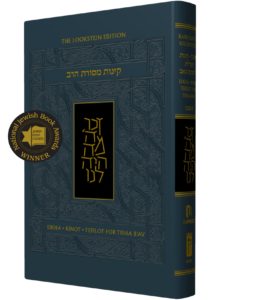Excerpted from the Koren Mesorat HaRav Kinot: Lookstein Edition. Edited by Rabbi Simon Posner, Kinot translated by Rabbi Dr. Tzvi Hersh Weinreb
 This kina (25), by Rabbi Kalonymos ben Yehuda of Speyer, laments the massacres perpetrated by the Crusaders in 1096, which destroyed the most prominent Jewish communities of the Rhineland. The main motif of this kina (מי יתן ראשי מים, Mi Yiten Roshi Mayim), a motif found in some of the prior kinot, is that the death of the righteous is equivalent to the burning of the Beit HaMikdash.
This kina (25), by Rabbi Kalonymos ben Yehuda of Speyer, laments the massacres perpetrated by the Crusaders in 1096, which destroyed the most prominent Jewish communities of the Rhineland. The main motif of this kina (מי יתן ראשי מים, Mi Yiten Roshi Mayim), a motif found in some of the prior kinot, is that the death of the righteous is equivalent to the burning of the Beit HaMikdash.
If we are to mourn for the Beit HaMikdash, we must also mourn the death of the great Torah scholars. Since the tragedy of the destruction of the Torah centers in Germany is equivalent to the Hurban Beit HaMikdash, we are justified in thinking that a special fast day should have been established to mourn for the martyrs of those massacres. However, the kina declares, we are not to add any fast day beyond Tisha B’Av to commemorate any other catastrophe, massacre, or destruction.
The phrase in the kina “אי תורה ותלמוד והלומדה, Where are Torah, Talmud, and students?” has a message. The message of this phrase of the kina is that it is important to mourn not only for the great scholars but for the ordinary Jews as well. One does not have to be a genius or a great teacher of Torah. All one has to do is study, at any level. This itself is part of mesora, the chain of tradition. Our mesora consists not only of brilliant scholars, but also of simple Jews who study even if they do not understand what they study.
The phrase “Where are Torah, Talmud, and students?” was the phrase used by a Holocaust survivor to describe to me his feelings at visiting Vilna on Kol Nidrei night in 1945. Shortly after he was liberated, he returned to Vilna where he had lived before the War, for the High Holidays. It is difficult to describe what Vilna looked like on Rosh HaShana and Yom Kippur before the War. In one neighborhood there were eight or nine synagogues, including the Beit Knesset HaGra and a synagogue that dated back to the Middle Ages. This person remembered what the Vilna shulhoif, the neighborhood where the synagogues were located, was like on Kol Nidrei night when tens of thousands of Jews would congregate. On that Kol Nidrei night in 1945, he returned to the synagogue where his mother used to pray, and it was deserted. He used the phrase from this kina to describe his feelings, “Where is the Torah and those who study it? Her place is desolate, with none to dwell therein.”
This survivor continued with a haunting story. His mother was a pious Jewess and of course attended shul on Yom Kippur. When it came time for Maftir Yonah, she used to leave the shul for half an hour and feed her cat at home. The cat would wait for her, and after feeding the cat she would return to shul. This man, who knew the cat, spent Yom Kippur of 1945 at the home where his parents had lived, and at 4:30 in the afternoon, there was a scratching at the door. It was the same cat waiting for him to feed her the way his mother had. This visit had a traumatic effect on him. At that moment, he felt the full magnitude of the Holocaust. Indescribable despair and bleakness overwhelmed him.
This story also illustrates how accurately Lamentations captures the devastation of the Ĥurban. When a place is desolate and devoid of human beings, it is tragic; but when animals prowl there, the pain is almost unbearable. As the verse in Lamentations (5:18) says, “For Mount Zion is desolate.” It is tragic that Mount Zion is desolate and deserted; but, not only are people absent, the verse continues, “foxes prowl over it.” The fox and the cat walk around. All he saw was the ruins of the synagogues and the cat prowling amidst the ruins. The only link between the past and present was the cat.

